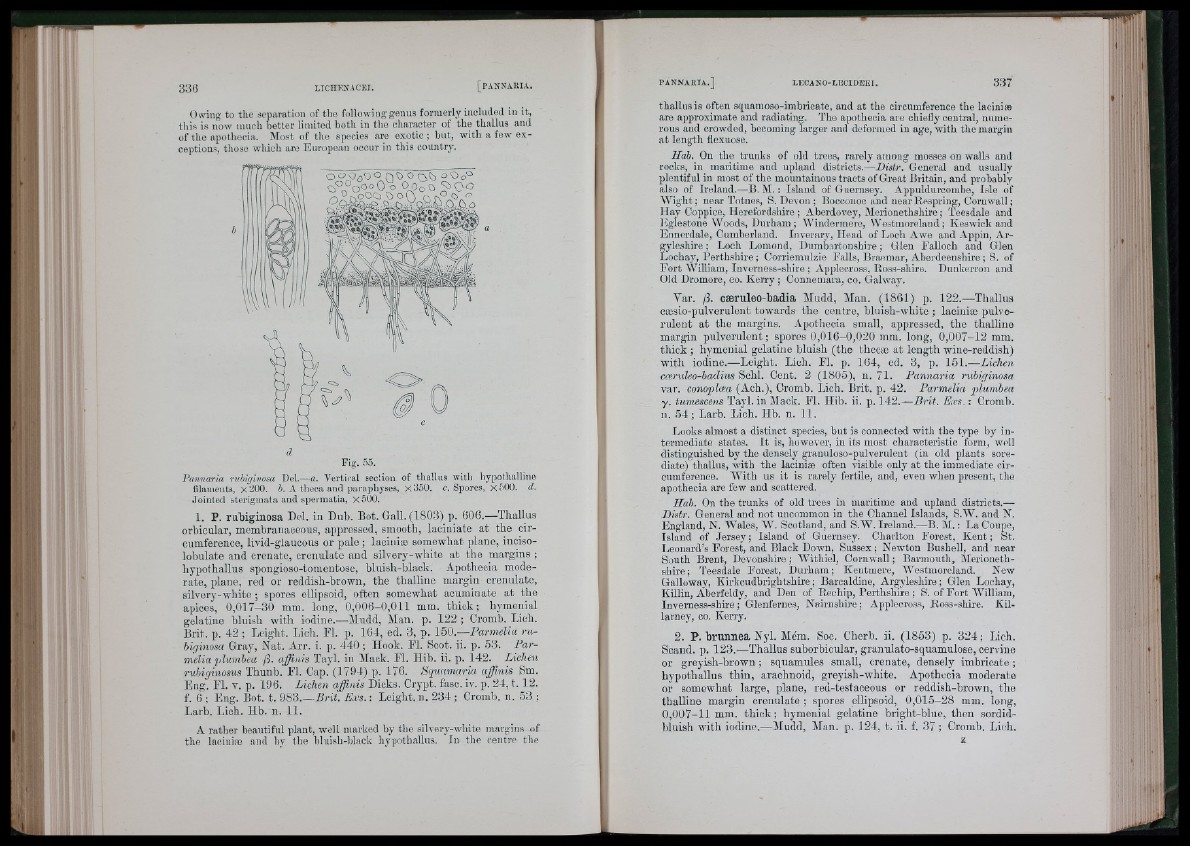
it,
ami
Owing to the separation of the folloAviug genus formerly included iu i
this is now mucli better limited both iu the character of the thallus an
of the apothecia. Most of the species are exotic; but, with a few exceptions,
those which are European occur in this country.
OOo O ^ O o
» noOcj A )o r\ o, f»Oo "
Fig. .03.
Pannarla rnhighiosa Del.—a. Vertical section of thallus with hypotlialline
filaments, x 2 0 0 . i. A theca and paraphyses, x 3 3 0 . c. Spores, Xf'OO. d.
Jointed sterigmata and spei-raatia, x5U0.
1. P. ru b ig in o s a Del. in Dub. Bot. Gall. (1803) p. 606.—Thallus
orbicular, membranaceous, appressed, smooth, laciniate a t the circumference,
livid-glaucous or pale ; laoiuiæ somewhat plane, inciso-
lobulato and crenate, crenulate and silvery-white a t the margins ;
hypothallus .spongioso-tomentose, bluish-black. Apothecia modera
te , plane, rod or reddish-brown, the thalline margin crenulate,
silvery-white ; spores ellipsoid, often someAvhat acuminate a t the
apices, 0 ,0 1 7 -3 0 mm. long, 0,0 0 6 -0 ,0 1 1 mm. th io k ; hymenial
gelatine bluish with iodine.—Mudd, Man. p. 122 ; Cromb. Lioh.
Brit. p. 42 ; Leight. Lich. Fl. p. 164, ed. 3, p. 150.— Parmelia ru-
l in t . VZ, l/Clgnc.men.I I . lu-i,eu.o,ro u .— i armeiia
biginosa Gray,__ Nat.M.i A * rr. :i. ..p. 4 .1 4 Ap..0 ; Tr„„Hook.u Fl.T?i Soot. ii. ..p. 53.770 Par-
P
melia plumbea p . affinis Tayl. in Alack. F l. Hib. ii. p. 142. Lichen
Lie.
ruhiginosus Thunb. Fl. Cap. (1794) p. 176. Squamaria ajjinis affinis Sm.
i
Eng. Fl. V. p. 196. Liehen affinis Dicks. Crypt, faso. iv. p. 24, t. 12.
f. 6 : Eng. Bot. t. 9 83.—B rit. E.vs. : Leight. n. 234 ; Cromb. n. 53 ;
Larb. Lioh. Hb. n. 11.
A rather beautiful plant, well marked by the silvery-white margins of
the laciuiæ aud hy the bluish-blaclc hypothallus. In the centre the
TPl
thallua is often squainoso-imbrieate, and at the circumference the laciniæ
are approximate and radiating. The apothecia are chiefly central, numerous
aud crowded, becoming larger aud deformed in age, with tlie margin
a t length flexuose.
liab. On the trunks of old trees, rarely among mosses on walls and
roeks, iu maritime aud upland districts.—Histr. General and usually
plentiful in most of the mountainous tracts of Great Britain, and probably
also of Ireland.—B, AI. : Island of Guernsey. Appuldurcombe, Isle of
AVight; near Totnes, S. Devon ; Bocconoc and nearllespring, Cornwall;
Hay Coppice, Herefordshire ; Aberdovey, Merionethshire ; Teesdale and
Eglestone Woods, Durham; Windermere, Westmoreland; Keswick and
Ennerdale, Cumberland. Inverary, Head of Loch A avo and Appin, Argyleshire
; Loch Lomond, Dumbartonshire ; Glen Falloch and Glen
Lochay, Perthsliire ; Corriemulzie Falls, Braemar, Aberdeeushire ; S. of
Fort William, luverness-shire ; Applecross, Ross-shire. Dunkerron and
Old Dromore, co. Kerry ; Connemara, co. Galway.
Var. p. caeruleo-badia Mudd, Man. (1861) p. 122.—Thallus
cæsio-pulverulcnt towards th e centro, bluish-white ; laciniæ pulveru
len t a t the margins. Apothecia small, appressed, the thalline
margin pulveru len t; spiores 0,0 1 6 -0 ,0 2 0 mm. long, 0 ,0 0 7 -1 2 mm.
thick ; hymenial gelatine bluish (th e theoæ a t length wine-reddish)
w ith iodine.—Leight. Lich. El. p. 164, ed. 3, p. 151.—Lichen
cceruleo-badius Schl. Cent. 2 (1805), n. 71. Pannaria rubiginosa
var. conoplcea (Aoh.), Cromb. Lioh. Brit. p. 42. Parmelia plumbea
y . tumescens Tayl. in Alack. El. Hib. ii. p. 142.— B rit. E.vs. : Cromb.
11. 5 4 ; Larb. Lioh. Hb. n. 11.
Looks almost a distinct species, but is connected with the type by intermediate
states. It is, however, iu its most characteristic form, well
distinguished by the densely granuloso-pulverulent (iu old plants sorediate)
thallus, with the laciniæ often visible only at the immediate circumference.
W ith us it is rarely fertile, and, even when present, the
apothecia are few and scattered.
Ilah. On the trunks of old trees in maritime and upland districts.—
Histr. General and not uncommon in the Channel Islauds, S.W. and N.
England, N. Wales, W. Scotland, and S.W. Ireland.—B. AI. ; La Coupe,
Island of Jersey; Island of Guernsey. Charlton Forest, Kent; St.
Leonard’s Forest, and Black Down, Sussex ; Neivtou Bushell, aud near
South Brent, Devonshire ; Withiel, Cornwall ; Barmouth, Alerionethshire;
I'eesdale Forest, Durham; Kentmere, AA'estmoreland. New
Galloway, Kirkcudbrightshire; Barcaldine, Argyleshire; Glen Lochay,
Killin, Aberfeldy, and Den of Rechip, Perthshire ; S. of F ort AA’illiam,
Inverness-shire; Glenfernes, Nairnshire; Apipiecross, Ross-shire. Killarney,
CO. Kerry.
2. P. b ru n n e a Nyl. Além. Soc. Cherb. ii. (1853) p. 324 ; Lich.
Scand. p. 123.—Thallus suborbicular, granulato-squamulose, cervine
or greyish-brown ; squamules small, crenate, densely imbricate ;
hypothallus th in , arachnoid, greyish-white. Apothecia moderate
or somewhat large, plane, red-testaceous or reddish-brown, the
thalline margin crenulate ; spores ellipsoid, 0 ,0 1 5 -2 8 mm. long,
0,007-11 mm. th ic k ; hymemal gelatine bright-blue, th en sordid-
bluish with iodine.—Aludd, Alan. p. 124, t. ii. f. 37 ; Cromb. Lich.
z
* '
: >1
' ll
4;[
I 'I